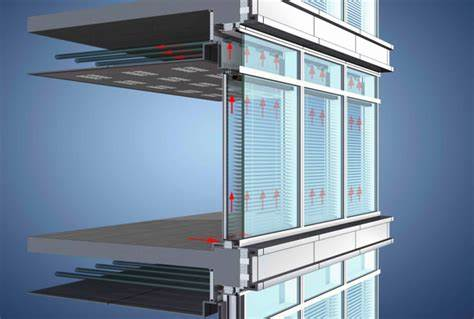In the world of architectural design, curtain wall systems have always been the primary means of creating aesthetically pleasing and functional facades. However, as sustainability and energy efficiency become more and more important, respiratory curtain wall is gradually appearing on our radar. respiratory curtain wall offers distinct advantages over traditional curtain wall systems, and understanding these differences can help architects, builders, and homeowners make informed decisions for their projects.
Introduction to Respiratory Curtain Wall

Respiratory curtain wall, also known as double-layer curtain wall, double-layer ventilated curtain wall, thermal channel curtain wall, etc., which consists of two curtain walls, inside and outside, between the inner and outer curtain wall to form a relatively closed space, the air can be from the lower intake into, and from the upper exhaust port out of this space, this space is often in the air flow state, the heat flow in this space.
Difference Between Respiratory Curtain Wall and Traditional Curtain Wall
Structural Style
Traditional Curtain Wall: It usually consists of panels and supporting structure, the structure is relatively simple and direct. The structure is relatively simple and straightforward. It is generally a single-layer sealing system, relying on materials such as sealant for waterproofing and sealing.
Respiratory Curtain Wall: It composed of two layers of curtain wall inside and outside, forming a relatively closed air interlayer. The outer curtain wall usually adopts materials such as single-layer glass or aluminium plate, which mainly plays a protective and decorative role; the inner curtain wall usually adopts energy-saving materials such as hollow glass, which has the functions of heat preservation, heat insulation, sound insulation, etc. The outer curtain wall is usually made of single-layer glass or aluminium plate, which mainly plays a protective and decorative role. The air layer realizes natural ventilation or mechanical ventilation by setting air inlet and outlet, so that air flows in the layer, forming a ‘breathing’ effect.

Energy-Saving Performance
Traditional Curtain Wall: relatively poor thermal insulation performance, which easily leads to faster heat exchange between indoor and outdoor, increasing the energy consumption of the building. In summer, the solar radiation heat through the glass makes the indoor temperature rise, requiring a large number of air conditioners to cool down; in winter, the indoor heat is easy to lose, requiring more energy consumption for heating.
Respiratory Curtain Wall: It has good heat preservation and insulation properties. In winter, the air in the air layer can play a certain role in insulation, reducing the loss of indoor heat; in summer, through the ventilation of the air layer, it can reduce the surface temperature of the outer curtain wall, reducing the transmission of solar radiation heat into the room, thus reducing air conditioning energy consumption. According to statistics, the breathing curtain wall can make the building energy-saving up to about 30% - 50%.
Comfort Level
Traditional Curtain Wall: Due to better sealing, the indoor air circulation is relatively poor, which is prone to problems such as stuffy heat and humidity, affecting the comfort of indoor personnel.
Respiratory Curtain Wall: Through the ventilation of the inter-air layer, it can effectively improve indoor air quality and keep the indoor air fresh. The air flow in the inter-air layer can take away the dirty indoor air and introduce fresh air to improve the comfort of indoor personnel.

Sound Insulation Performance
Traditional Curtain Wall: It sounds insulation effect is limited, and the ability to block external noise, especially low-frequency noise such as traffic noise, is weak.
Respiratory Curtain Wall: As the air layer between the inner and outer layers of the curtain wall has a certain sound insulation effect, it can effectively reduce the incoming external noise. The air in the inter-air layer can absorb and reflect part of the noise and improve the sound insulation performance of the curtain wall.
Environmental Performance
Traditional Curtain Wall: In the process of production and use, it may produce some environmental pollution. For example, the production process of glass consumes a lot of energy and resources and emits certain pollutants; materials such as sealants may release harmful substances such as volatile organic compounds (VOCs) during use.
Respiratory Curtain Wall: Adopting more environmentally friendly materials and technologies to reduce pollution to the environment. For example, the use of low-e glass and renewable materials reduces energy consumption and resource waste; carbon emissions are reduced by optimising ventilation systems and reducing reliance on air conditioning and heating equipment.

As the architectural landscape continues to evolve, respiratory curtain walls represent a major advancement in architectural design. By addressing the limitations of traditional curtain walling, this innovative system provides a sustainable, energy efficient and aesthetically pleasing solution for modern architecture. Respiratory curtain wall is a compelling option for architects and builders looking to create spaces where form and function go hand in hand, in line with the future direction of sustainable architecture. For more information, please contact info@gkbmgroup.com
Post time: Oct-11-2024




